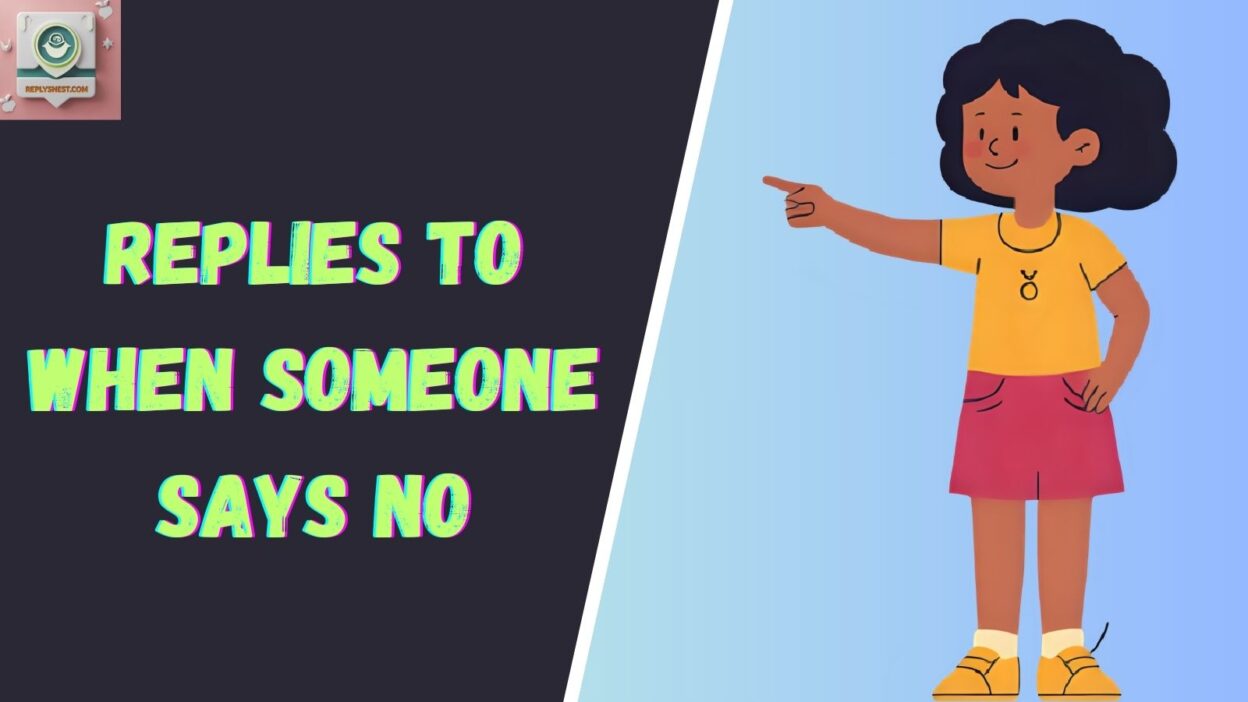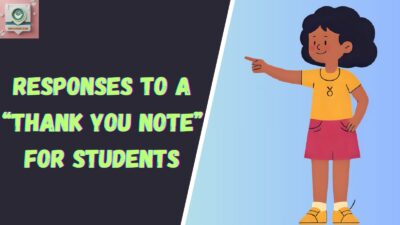When someone says “no”, it can feel like a door closing—or, if handled gently, like a window opening to better understanding. How we respond to rejection, disagreement, or refusal says a lot about our emotional intelligence and our ability to connect with others. A thoughtful reply not only respects the other person’s boundaries but also keeps the conversation warm, respectful, and sometimes even playful. Replies to When Someone Says No.
When someone says no, my first instinct is to understand the situation before reacting. Over the years, I’ve learned that a direct yet warm acknowledgement can show respect for their decision. A simple “thanks for considering” or expressing appreciation for their time and effort keeps the interaction positive. Sometimes, I’ll ask why—not in a challenging way, but to gain a brief explanation that might allow me to accept their answer or even share something that could open future opportunities.
I keep in mind that pressuring for a change can cross a boundary, so I aim to reinforce a tone that is clear, prepared, and willing to stay professional. When the conversation calls for humor, I might drop a light “ding—apathy wins” or something sweet but casual, which helps ease any emotional weight.
In closer relationships, whether with a partner, friends, or colleagues, my replies are shaped by the value I place on the connection. I’ve used playful lines like “you’re cute” in flirtation, or even a joking “Batman” reply in a friendly setting to lighten the mood. When matters are more serious, I may circle back later with a thoughtful, assertive follow-up, showing I’ve considered their input.
In tense moments, a calm and composed approach—rooted in empathy, compassion, and mutual respect—prevents arguments from escalating. I avoid pretending indifference; instead, I let them know I hear them and appreciate their honesty. This mix of humor, respect, and clarity has not only improved my communication but also reinforced trust across different stages of every important conversation.
1. “I completely understand.”
Best use: When you want to show respect for someone’s decision without pushing further.
Not to use: When you actually don’t understand and need clarification.
Other ways to say: “That makes sense,” “I get it,” or “I see where you’re coming from.”
Example:
Friend: “Sorry, I can’t join dinner tonight.”
You: “I completely understand. Maybe another time!”
Read More: Best Responses to “Happy Canada Day”
2. “That’s totally fair.”
Best use: When someone sets a boundary and you want to validate it.
Not to use: When you secretly feel hurt and might come across as sarcastic.
Other ways to say: “That’s reasonable,” “Fair enough,” or “I respect that.”
Example:
Colleague: “No, I can’t take on another task right now.”
You: “That’s totally fair. I appreciate your honesty.”
3. “Thanks for letting me know.”
Best use: When you appreciate honesty even if it’s a refusal.
Not to use: When you feel bitter—it can sound passive-aggressive if your tone is off.
Other ways to say: “I appreciate you telling me,” “Good to know,” or “Thanks for being upfront.”
Example:
Roommate: “No, I don’t want to split the subscription.”
You: “Thanks for letting me know. I’ll figure something else out.”
4. “No worries at all.”
Best use: To ease tension when the other person seems guilty for saying no.
Not to use: If you actually are worried—it may come across as dismissive.
Other ways to say: “That’s okay,” “No problem,” or “It’s all good.”
Example:
Neighbor: “Sorry, no, I can’t water your plants this weekend.”
You: “No worries at all! I’ll ask someone else.”
5. “I appreciate your honesty.”
Best use: When you admire someone’s courage in saying no.
Not to use: If the “no” feels harsh and you’re not ready to acknowledge it.
Other ways to say: “Thanks for being straightforward,” “I value your openness.”
Example:
Friend: “No, I’m not comfortable with that plan.”
You: “I appreciate your honesty—it helps me understand you better.”
6. “I respect that.”
Best use: When you want to highlight respect for boundaries.
Not to use: When you secretly don’t respect it—it might sound insincere.
Other ways to say: “I honor your choice,” “I hear you,” or “That’s your call.”
Example:
Coworker: “No, I can’t work late tonight.”
You: “I respect that. Family time matters.”
7. “It’s okay, I’ll manage.”
Best use: When you want to show independence after being refused.
Not to use: If you actually need help urgently.
Other ways to say: “I’ll figure it out,” “I can handle it,” or “No problem, I’ll work around it.”
Example:
Sibling: “No, I can’t drive you tomorrow.”
You: “It’s okay, I’ll manage with a cab.”
8. “Maybe another time.”
Best use: When you want to keep the door open for future opportunities.
Not to use: When you know the “no” is permanent.
Other ways to say: “We’ll catch up later,” “Next time, then,” or “We’ll make it happen someday.”
Example:
Friend: “No, I can’t hang out today.”
You: “No worries, maybe another time!”
9. “I get where you’re coming from.”
Best use: To show empathy and alignment.
Not to use: If you don’t actually understand their reasoning.
Other ways to say: “That makes sense,” “I see your perspective.”
Example:
Coworker: “No, I prefer sticking with our current plan.”
You: “I get where you’re coming from—it has worked well so far.”
10. “That’s okay, thank you for considering it.”
Best use: When someone thought about it before saying no.
Not to use: If they refused harshly without consideration.
Other ways to say: “I appreciate you thinking about it,” “Thanks for taking the time.”
Example:
Friend: “No, I can’t lend you the book.”
You: “That’s okay, thank you for considering it.”
11. “I hear you.”
Best use: To validate someone’s voice and opinion.
Not to use: If you’re not truly listening.
Other ways to say: “I understand,” “Got it,” “I’m listening.”
Example:
Partner: “No, I don’t feel comfortable with that.”
You: “I hear you. Let’s try a different idea.”
12. “That’s cool.”
Best use: In casual or friendly settings.
Not to use: In professional or sensitive conversations.
Other ways to say: “All good,” “No problem,” “Sounds fine.”
Example:
Friend: “No, I don’t want dessert.”
You: “That’s cool. More for me!”
13. “All right, thanks for being upfront.”
Best use: When you value directness.
Not to use: If their “no” was already blunt and needs softening.
Other ways to say: “Thanks for your honesty,” “I appreciate the clarity.”
Example:
Boss: “No, we can’t increase your budget.”
You: “All right, thanks for being upfront.”
14. “I appreciate your clarity.”
Best use: When someone’s refusal helps you avoid confusion.
Not to use: When their “no” was vague.
Other ways to say: “Thanks for the clear answer,” “I like how straightforward you are.”
Example:
Colleague: “No, I won’t be able to attend the meeting.”
You: “I appreciate your clarity—it helps me plan better.”
15. “Got it.”
Best use: Quick acknowledgment without overthinking.
Not to use: In serious or emotional matters where more warmth is needed.
Other ways to say: “Understood,” “Noted,” “Okay.”
Example:
Friend: “No, I can’t make it tomorrow.”
You: “Got it, thanks!”
16. “That makes sense.”
Best use: When you genuinely agree with their reasoning.
Not to use: When you don’t understand but say it anyway.
Other ways to say: “I see your point,” “I get that.”
Example:
Coworker: “No, it’s better to wait before launching.”
You: “That makes sense. We’ll hold off.”
17. “Thanks for telling me directly.”
Best use: When you value straightforward communication.
Not to use: If their “no” was harsh and unkind.
Other ways to say: “I like that you’re direct,” “I appreciate the honesty.”
Example:
Friend: “No, I don’t enjoy that type of movie.”
You: “Thanks for telling me directly. Let’s pick something else.”
18. “I’m glad you shared that.”
Best use: When a “no” leads to better understanding.
Not to use: When you actually feel frustrated by the refusal.
Other ways to say: “I appreciate you sharing your thoughts,” “That’s good to know.”
Example:
Partner: “No, I’m not comfortable with that plan.”
You: “I’m glad you shared that—we can adjust.”
19. “It’s not a problem.”
Best use: To minimize stress for the other person.
Not to use: When the refusal genuinely creates a problem for you.
Other ways to say: “Don’t worry,” “That’s fine,” “No big deal.”
Example:
Neighbor: “No, I can’t lend you my ladder.”
You: “It’s not a problem, I’ll find another way.”
20. “No hard feelings.”
Best use: When you want to show maturity and peace.
Not to use: If you’re secretly upset—it might sound passive-aggressive.
Other ways to say: “It’s all good,” “No resentment,” “We’re cool.”
Example:
Friend: “No, I don’t want to go there.”
You: “No hard feelings. Let’s pick another spot.”
21. “I respect your decision.”
Best use: When you want to emphasize respect for autonomy.
Not to use: If you’re planning to pressure them later.
Other ways to say: “That’s your choice,” “I support your call.”
Example:
Coworker: “No, I’d rather not participate.”
You: “I respect your decision.”
22. “I’ll work around it.”
Best use: When you want to show flexibility.
Not to use: If the “no” truly blocks your progress.
Other ways to say: “I’ll adjust,” “I’ll figure out another way.”
Example:
Team member: “No, I can’t attend the event.”
You: “I’ll work around it. Thanks for letting me know.”
23. “That’s fine by me.”
Best use: When you’re easygoing about the refusal.
Not to use: In formal business discussions.
Other ways to say: “That works,” “I’m okay with that.”
Example:
Friend: “No, let’s not order pizza tonight.”
You: “That’s fine by me—what about tacos?”
24. “Thanks for considering it, anyway.”
Best use: When the person at least thought about your request.
Not to use: If they dismissed it without thought.
Other ways to say: “I appreciate your time,” “Thanks for thinking it over.”
Example:
Coworker: “No, I can’t switch shifts.”
You: “Thanks for considering it, anyway.”
25. “I appreciate your perspective.”
Best use: When the “no” comes from thoughtful reasoning.
Not to use: When the refusal feels unfair or biased.
Other ways to say: “I value your opinion,” “Thanks for sharing your view.”
Example:
Colleague: “No, I think we should hold off for now.”
You: “I appreciate your perspective—it’s helpful to consider.”
Conclusion
Hearing “no” doesn’t have to be the end of the conversation. It can be the beginning of mutual respect, empathy, and understanding. By responding with warmth, care, and thoughtful phrasing, you turn moments of refusal into opportunities for deeper trust. Whether it’s at work, in friendships, or in family life, these responses remind others that their voice matters—and so does kindness in communication.
Editor’s Picks: 10 Best Replies People Love Most
- “I completely understand.” – because it shows instant empathy.
- “Thanks for letting me know.” – because honesty deserves acknowledgment.
- “No worries at all.” – because it lightens the mood.
- “Maybe another time.” – because it keeps the door open.
- “I respect that.” – because boundaries should be honored.
- “That makes sense.” – because validation is powerful.
- “I appreciate your honesty.” – because sincerity builds trust.
- “No hard feelings.” – because forgiveness fosters peace.
- “I’ll work around it.” – because flexibility makes life easier.
- “I appreciate your perspective.” – because it acknowledges thoughtfulness.



